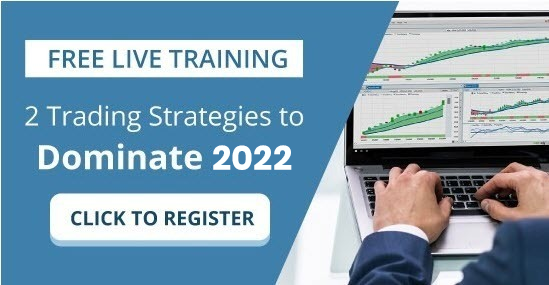It’s been two weeks since Jerome Powell made his 8-minute speech in Jackson Hole, Wyoming. I’ve listened to the speech numerous times. I’ve read the transcript multiple times. What’s striking about the speech is Powell mentioned the word “inflation” 46 times and ended his short talk by stating: “we will keep at it until we are confident that the job is done.”
Call me a nerd but it is rare that you hear anyone mention the word “inflation” 5.75 times a minute!
But here are the cold hard facts. Since 1971 when President Nixon closed the gold window, inflation has averaged 3.98% per year according to the Bureau of Labor Statistics. Since the last print of the Consumer Price Index was 8.5% you can certainly understand why Chairman Powell would mention place inflation center stage. Particularly since the inflation rates he is trying to manage are more than 100% higher than his predecessors.
What is also notable are the side effects or outcomes that have occurred since the speech.
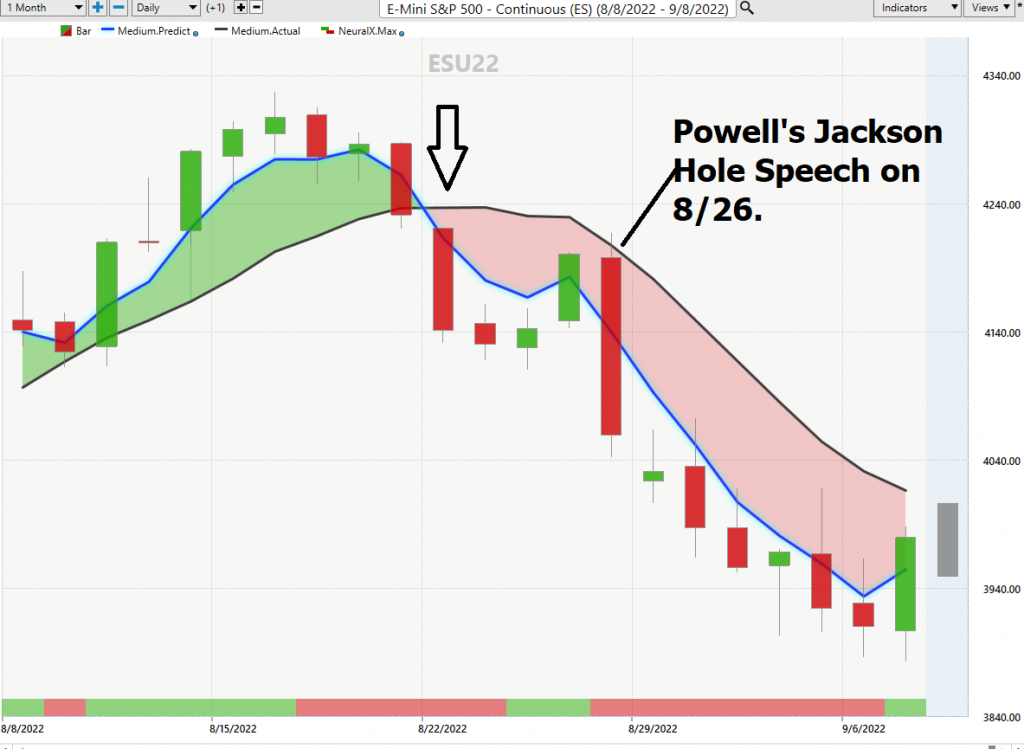
The S&P 500 sold off another 5%.
The NASDAQ declined another 5.63%.
The Dow Jones Industrial fell 4%.
Even Gold which would normally rally when the stock markets tumble , moved down 2.9%.
Most readers of this blog know I’m not a big fan of the Federal Reserve. I consider a centralized monetary authority to be archaic, inefficient, and prone to massive mismanagement. Nonetheless, they are the 800-pound gorilla in the economy, and we need to pay attention to what they are doing to make sure we are not adversely affected by their policies.
Wall Street and financial media have been hungry for the Fed to pivot and reverse course of their monetary tightening and raising of interest rates. Any trader with marginal awareness has had to admit that the stock market in 2020 and 2021 was marked by massive “stimulus.” Today, in the absence of stimulus it is challenging to develop a fundamental thesis as to why and how stocks would move higher.
Over the past 10 months since the Fed began talking about raising interest rates the U.S. Dollar has surged and acted like a giant wrecking ball to international trade and foreign economies. This has also forced the broader stock market indexes lower by about 15% year over year.
Hedge Fund Wizard, Stanley Druckenmiller recently observed the following:
- Whenever inflation gets higher than 5% it never comes down unless the Fed Funds rate is higher than the Consumer Price Index. Currently, the Fed Funds rate is 2.25% to 2.5%. This postulates that FED would have to raise another 600 basis points just to reach an equilibrium according to Druckenmiller’s thesis.
- Whenever inflation gets higher than 5%, it has never been tamed in the absence of a recession.
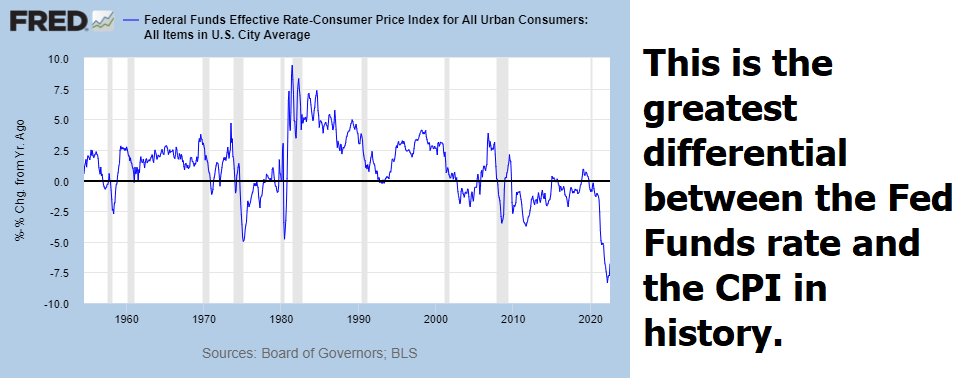
Druckenmiller is a hedge fund manager, market wizard, and trader who has generated some of the highest compounded returns in history. He is known for his disciplined and methodical approach to investing, as well as his willingness to take big risks. Druckenmiller began his career working for legendary investor George Soros. He later went on to start his own hedge fund, Duquesne Capital, which he ran for over two decades. In 2010, Druckenmiller announced his retirement from hedge fund management, but he remains an active investor and philanthropist. Through his hedge fund and personal investments, Druckenmiller has amassed a fortune of over $4 billion.
If Druckenmillers’ observation proves to be accurate, we would expect rallies in stocks to be short-lived and for downtrends in financial assets to proliferate.
Investors be forewarned. Should the Fed continue increasing interest rates stocks will face perpetual headwinds.
In the current economic environment sometimes, the best opportunities lie in looking at deteriorating assets in the options markets.
Let me explain.
Stock options are a type of financial derivative that gives the holder the right to buy or sell an underlying stock at a strike price on or before an expiration date. The strike price is typically set at the market price of the underlying stock on the date the option contract is created. The option holder pays a premium to the option writer for this right. If, at expiration, the market price of the underlying stock is above the strike price, the option holder will exercise their right to buy the stock at strike and sell it in the open market for a profit. If the market price of the underlying stock is below strike price at expiration, the option will expire worthless, and the option holder will lose their entire premium. Stock options are traded on major US exchanges such as the New York Stock Exchange (NYSE) and Chicago Board Options Exchange (CBOE). They are also traded over the counter (OTC) in European markets.
What is vitally important to remember when trading options is that they are deteriorating assets and their pricing is primarily determined by the volatility of the underlying market. Since all options have a fixed expiration date, we can mathematically determine what the value of the option will be worth tomorrow should volatility remain constant. With this knowledge traders can look to create regular income streams by selling call options and collecting the associated premiums.
This approach to options trading very similar to a landlord who is simply trying to collect rent checks on a regular basis.
Call options give the holder the right, but not the obligation, to buy a fixed number of shares of the underlying security at an agreed upon strike price on or before the expiration date. By selling a call option, the trader, like a landlord, collects a premium from the buyer as income. If the market is down trending, it is more likely that the option will expire worthless, allowing the seller to keep the entire premium. For the option to be profitable for the buyer, the price of the underlying security would need to rise above the strike price plus the premium paid. Therefore, when selling options in a down trending market, there is a higher probability of profit.
We discussed options in previous blog posts which you can find here:
Options Trading for Beginners – Part 1 Buying Call Options
Options Trading for Beginners – Part 2 Buying Put Options
Options Trading for Beginners – Part 3 Selling Call Options
Options Trading for Beginners – Part 4 Selling Put Options
The trading strategy that is worthy of your attention in the current market environment is learning how to sell Call Options and collecting premium.
Let’s assume that XYZ is trading at $100 per share.
The October 100 call option is trading at $5. Since every option contract is 100 shares this premium is $500. By selling this option a trader is collecting the premium today and agreeing to make delivery of the shares of XYZ at $100 per share at the October option expiration date.
This is what the risk reward profile would look like:
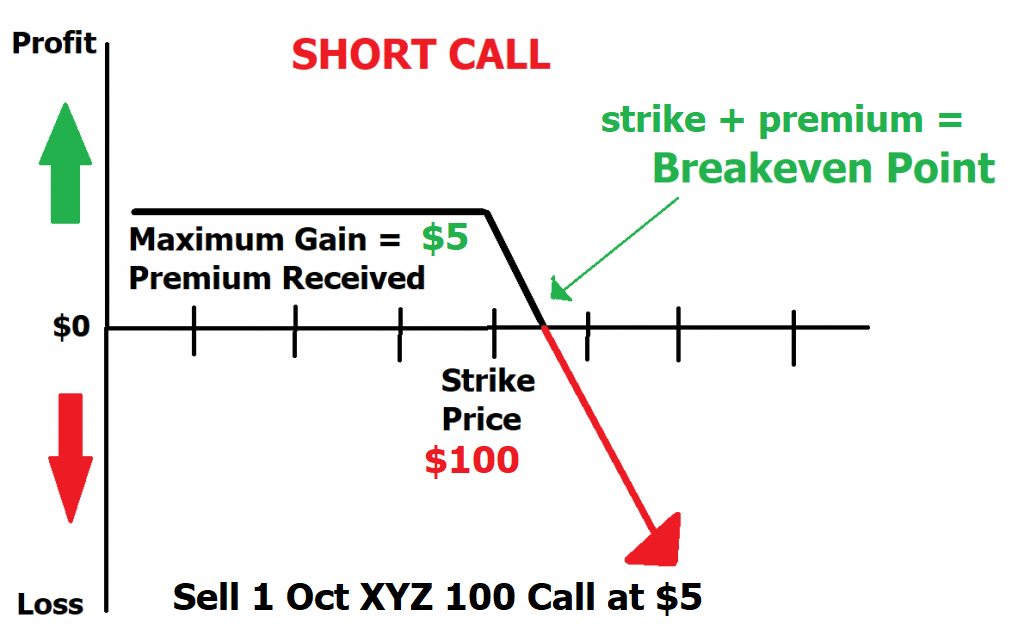
We can see for the risk/reward profile that the most amount of money this strategy can make is the premium collected of $5.
Theoretically, the risk is unlimited. Note, theoretically, the stock could go to infinity. However, we must balance that assumption against the hard cold probabilities. Also, as the option seller you can close out your position at any time you choose to do so and use traditional stop losses.
Here is why this tactic can be attractive to some.
There are 30 days till option expiration. Think of it this way: an option is a time-sensitive contract with a beginning and an end. The closer to the end of that contract, the less time there is for things to move in your favor. Just like how you’d pay more for a one-day insurance policy than you would for a one-year policy, time decay leads to premium deterioration the closer you get to expiration. An easy way to visualize time decay is with a diagram called “Theta.” Time decay is represented by Theta’s downward slope, with the steeper the slope indicating greater time decay. Thus, it’s important for beginner traders to keep time decay in mind when making decisions about their options contracts. Time decay is a critical concept for options traders to understand, because it plays a big role in how options prices move over time. In general, time decay refers to the idea that an option’s value will decrease as the days left until expiration get shorter. This is due to a number of factors, but the most important one is the time value of money – the longer you have until expiration, the more time there is for things to happen that could affect the price of the underlying asset, and therefore the option. As expiration gets closer, there’s less time for anything to happen, so the option becomes less valuable. This deterioration in value is time decay.
With this information we can deduce the following:
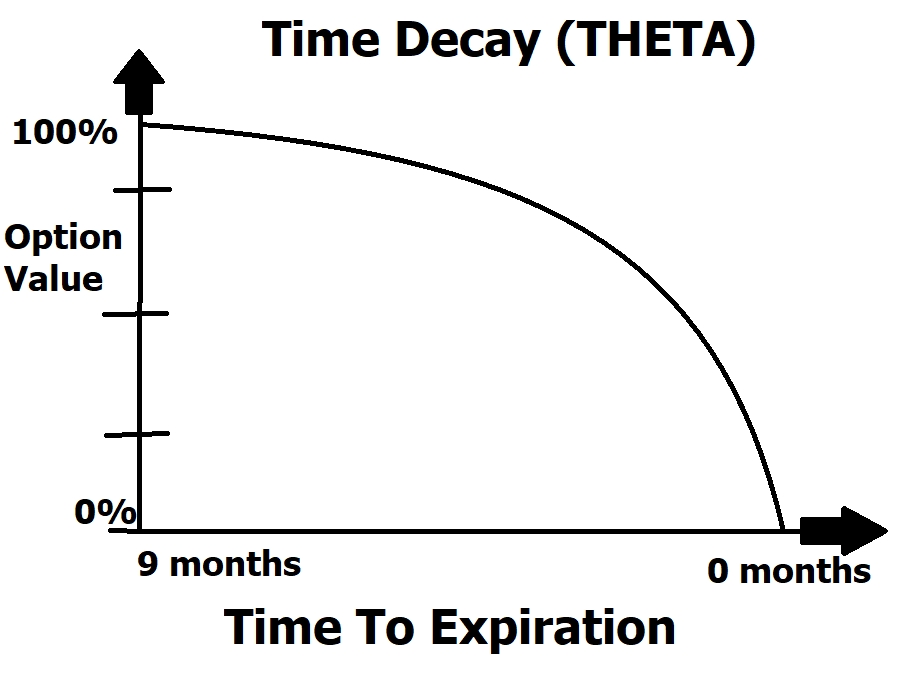
When we divide the option premium of $500 by 30 days, we determine the cost of RENT or time decay that a buyer of the option is looking to pay for the right to own this call option. This works out to roughly $17 per day of RENT that this option will decay in value, all things considered equal.
This call option will decay $170 in value every ten days.
It will expire worthless at any price under $100 at expiration.
Assuming that XYZ stock is in a downtrend this is a trade that puts the probabilities in your favor by selling it. The stock would have to rally $5 for the option to retain its full value at expiration date.
The call option buyer needs the underlying stock to rally more than 5% at expiration for them to make money.
Since this options contract expires in 30 days the closer it gets to expiration the faster the option premium will deteriorate.
Here is what the transaction looks like at different prices at expiration.
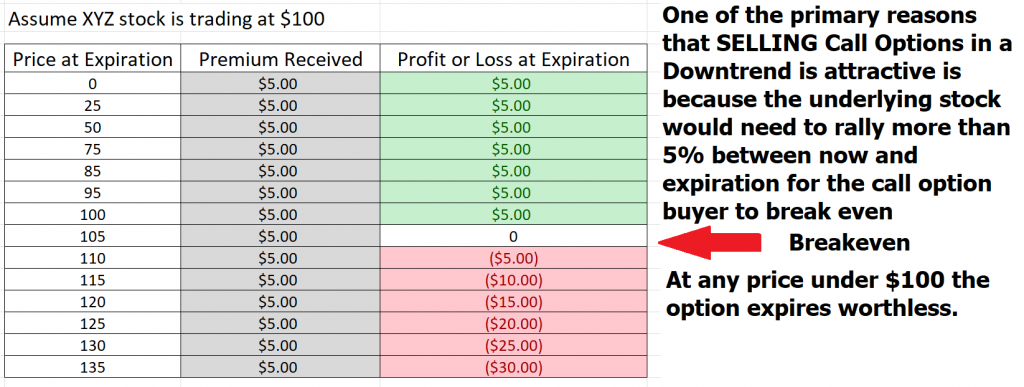
Notice how the maximum profit is the premium received.
As a call option seller, the most amount of money that you can make is the premium you receive for creating the obligation that you will make delivery of the shares at the agreed-upon strike price. In a down trending market selling call options is a powerful income producing tactic used by professional traders.
As the Option Seller you can liquidate your position at any time and are not required to hold it till expiration. Option seller can also use stop losses to make sure that losses are manageable.
Initially it may not sound attractive to sell a call option where your maximum gain is only $500. But in a down trending market, you’re putting time decay on your side as well as the expected lower prices for the underlying stock.
If you trade long enough, what you could quickly come to appreciate is great traders place immense value on odds and probabilities. Odds and probabilities are the foundation of statistics. Experience teaches us what makes long-term success possible is having an “edge.”
I don’t know if Druckenmiller’s observation will prove to be accurate. But I do know artificial intelligence is capable of providing me with trend analysis that historically has proven to be up to 87.4% accurate.
We discuss these ideas and concepts in our Live Training Masterclass which I invite you to attend.
How do you define OPPORTUNITY when trading inflationary markets?
What has your portfolios performance looked like while inflation has been running at current levels?
If you study the headlines, you’ll mostly find that the journalists, politicians, and monetary authorities are wrong.
The beauty of neural networks, artificial intelligence, and machine learning are they are fundamentally focused on pattern recognition to determine the best move forward. When these technologies flash a change in forecast – pay attention, it is newsworthy.
We often do not understand why something is occurring but that does not mean that we cannot take advantage of it.
Remember What’s Important.
Price is the only thing that matters when we are trading. It is what can make you wealthy or decimate your account. Everything else is just noise.
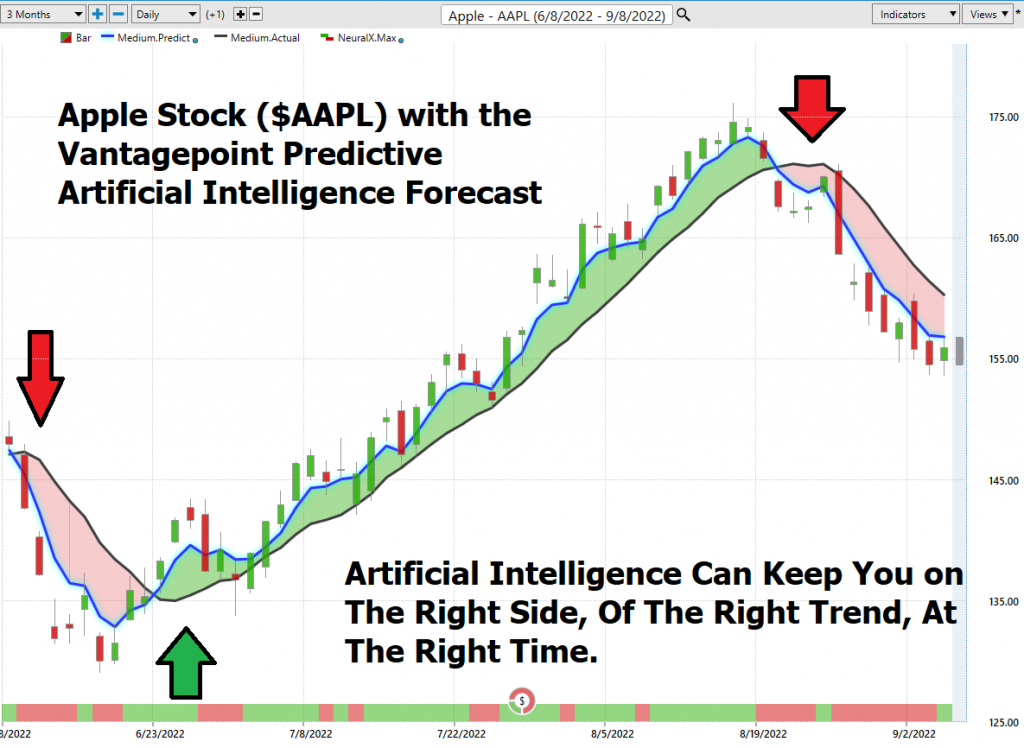
Are you capable of finding those markets with the best risk/reward ratios out of the thousands of trading opportunities that exist?
Knowledge.
Useful knowledge.
And its application is what A.I. delivers.
Isn’t that what we all want from the markets? Consistency.
So, imagine what might your portfolio would look like today had you applied artificial intelligence to it five years ago.
See for yourself how a machine-based learning software makes it easier to find statistically solid trends with less risk.
Most traditional indicators that traders use today were developed in the 1970’s and 1980’s. They are incapable of telling you what the market is going to do moving forward.
Once again, machine outperforms humanoid.
Since artificial intelligence has beaten humans at Chess, Poker, Blackjack, Go and Jeopardy, why do we think that trading would be any different?
It’s important that you find out more and discover why artificial intelligence keeps traders on the right side of the trend at the right time.
Join us for a FREE, Live Training. We’ll show you at least three stocks that have been identified by the A.I. that are poised for big movement… and remember, movement of any kind is an opportunity!
Discover why artificial intelligence is the solution professional traders go-to for less risk, more rewards, and guaranteed peace of mind.
Visit with us and check out the A.I. at our Next Live Training.
It’s not magic. It’s machine learning.
Make it count.
IMPORTANT NOTICE!
THERE IS SUBSTANTIAL RISK OF LOSS ASSOCIATED WITH TRADING. ONLY RISK CAPITAL SHOULD BE USED TO TRADE. TRADING STOCKS, FUTURES, OPTIONS, FOREX, AND ETFs IS NOT SUITABLE FOR EVERYONE.
DISCLAIMER: STOCKS, FUTURES, OPTIONS, ETFs AND CURRENCY TRADING ALL HAVE LARGE POTENTIAL REWARDS, BUT THEY ALSO HAVE LARGE POTENTIAL RISK. YOU MUST BE AWARE OF THE RISKS AND BE WILLING TO ACCEPT THEM IN ORDER TO INVEST IN THESE MARKETS. DON’T TRADE WITH MONEY YOU CAN’T AFFORD TO LOSE. THIS ARTICLE AND WEBSITE IS NEITHER A SOLICITATION NOR AN OFFER TO BUY/SELL FUTURES, OPTIONS, STOCKS, OR CURRENCIES. NO REPRESENTATION IS BEING MADE THAT ANY ACCOUNT WILL OR IS LIKELY TO ACHIEVE PROFITS OR LOSSES SIMILAR TO THOSE DISCUSSED ON THIS ARTICLE OR WEBSITE. THE PAST PERFORMANCE OF ANY TRADING SYSTEM OR METHODOLOGY IS NOT NECESSARILY INDICATIVE OF FUTURE RESULTS. CFTC RULE 4.41 – HYPOTHETICAL OR SIMULATED PERFORMANCE RESULTS HAVE CERTAIN LIMITATIONS. UNLIKE AN ACTUAL PERFORMANCE RECORD, SIMULATED RESULTS DO NOT REPRESENT ACTUAL TRADING. ALSO, SINCE THE TRADES HAVE NOT BEEN EXECUTED, THE RESULTS MAY HAVE UNDER-OR-OVER COMPENSATED FOR THE IMPACT, IF ANY, OF CERTAIN MARKET FACTORS, SUCH AS LACK OF LIQUIDITY. SIMULATED TRADING PROGRAMS IN GENERAL ARE ALSO SUBJECT TO THE FACT THAT THEY ARE DESIGNED WITH THE BENEFIT OF HINDSIGHT. NO REPRESENTATION IS BEING MADE THAT ANY ACCOUNT WILL OR IS LIKELY TO ACHIEVE PROFIT OR LOSSES SIMILAR TO THOSE SHOWN.


